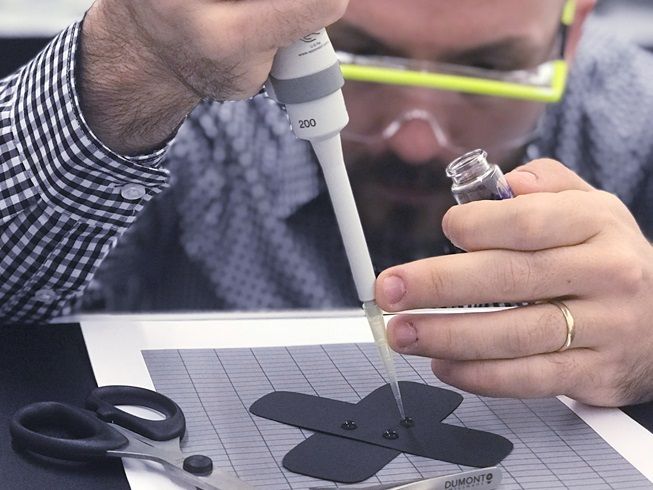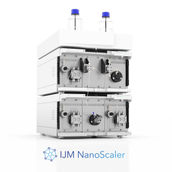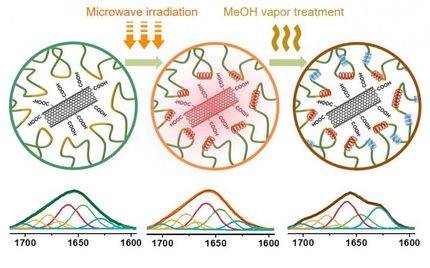Medication you can wear
Drug equipped polymer fibers
Drug-releasing textiles could, for instance, be used to treat skin wounds. Empa researchers are currently developing polymer fibers that can be equipped with drugs. The smart fibers recognize the need for therapy all by themselves and dose the active ingredients with precision and accuracy.

In the future, textiles could be used for the precise and precise processing of drugs.
Empa
For the «Self Care Materials» project, fibers are produced from biodegradable polymers using various processes. «The targeted use of the fiber determines which manufacturing process is best,» explains Empa researcher and project coordinator René Rossi. Delicate, light membranes with a large surface are formed during so-called electrospinning. If robust fibers are required, e.g. for protective cloth-ing, it is better to draw the melted ingredients. In the end, all processes produce novel fibers, the nano-architecture of which is made up of several layers and components. «The properties of these new materials are currently being investigated with test substances,» says Rossi. In the finished product, for example, antibiotics or painkillers are to be integrated into the fibers.
In order to ensure that the dosage of the active substances is precisely as needed, the researchers have devised a tricky control mechanism: Some polymers are degradable by the body under certain conditions. This property can be used specifically. Rossi: «In response to a stimulus from the body, the fibers should release their drugs into the environment at a calculated degradation rate.» Such an irritation can be the altered pH value of a skin wound, which indicates that the tissue damage must be treated. As a so-called self-care material, the fibers in the form of a plaster or garment thus support the diagnosis and treatment of diseases.
«The use of self-care fibers is conceivable for an enormous number of applications,» says Rossi. In addition to chemical signals from the body, however, stimuli can also be used that are deliberately set from the outside to control the release of medication by the fibers. Textiles or dressings that release a remedy under slight pressure or a stimulus of light can contribute to the quality of life of pa-tients and at the same time relieve the burden on health care staff.
The system can also be used for preventive measures. The idea behind it: Where active substances can be released, substances are also able to penetrate the fiber in the opposite direction. ”Thus, the fibers can act as sensors and, for instance, measure the sugar level in the blood,» explains Rossi. In the case of premature babies, the sugar balance is particularly likely to be out of balance. With the help of such sensors, blood sugar can be monitored painlessly through the tender skin without the babies having to suffer from a prickly blood sample.
For the CCMX project, the team of Empa and EPFL scientists is conducting joint research into the further development of smart medical fibers until 2020. 20 companies have so far been won as industrial partners, including Syngenta and – as the latest addition – Nanosurf from Liestal. The industry association Swiss Textiles and the research initiative of the Swiss textile manufacturers Subitex are also involved in the project.
Most read news
Other news from the department science
These products might interest you

Pharmaceutical Substances by Thieme Verlag
Look up Industrial Syntheses of 2,600 APIs
Your tool for Syntheses, Patents and Applications – Pharmaceutical Substances

KNAUER IJM NanoScaler by KNAUER
Efficient formulation of lipid nanoparticles for RNA-based therapies
Optimise drug encapsulation from 1 ml to hundreds of millilitres with minimal drug input

Get the life science industry in your inbox
By submitting this form you agree that LUMITOS AG will send you the newsletter(s) selected above by email. Your data will not be passed on to third parties. Your data will be stored and processed in accordance with our data protection regulations. LUMITOS may contact you by email for the purpose of advertising or market and opinion surveys. You can revoke your consent at any time without giving reasons to LUMITOS AG, Ernst-Augustin-Str. 2, 12489 Berlin, Germany or by e-mail at revoke@lumitos.com with effect for the future. In addition, each email contains a link to unsubscribe from the corresponding newsletter.





















































